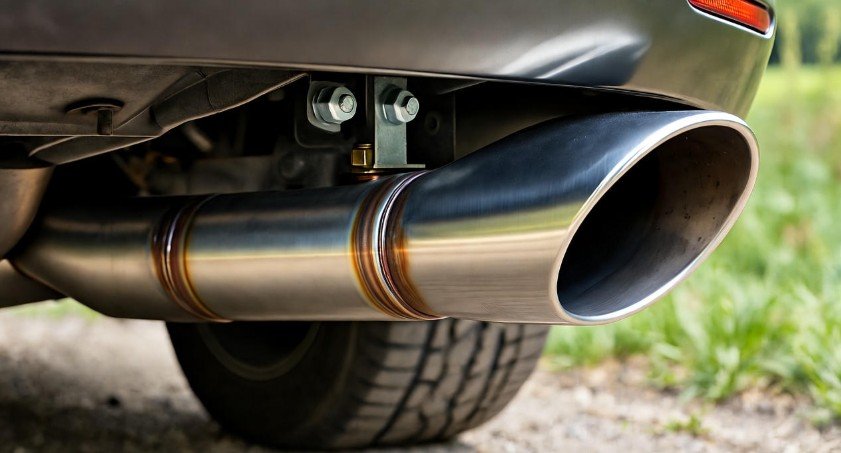How Is Exhaust Pipe Measured? Unlock Sizing Secrets!

When it comes to maintaining or upgrading your vehicle, one part that often gets overlooked is the exhaust system. Many car enthusiasts and everyday drivers underestimate the importance of a properly sized exhaust pipe. Yet, knowing how is exhaust pipe measured is essential for ensuring your vehicle performs at its best, reduces emissions, and even sounds the way you want it to. Whether you’re installing a new aftermarket pipe or simply checking your existing setup, understanding the intricacies of exhaust pipe measurement can save you money, time, and headaches. In this guide, we’ll explore everything from diameter and length to bends, angles, and material considerations, helping you make informed decisions about your car.
Why Correct Exhaust Pipe Measurement Matters
You might wonder, “Why does measuring an exhaust pipe even matter?” The answer lies in performance, efficiency, and safety. A pipe that is too small can restrict airflow, forcing your engine to work harder, which can lower fuel efficiency and reduce horsepower. On the other hand, a pipe that is too large can decrease backpressure, negatively affecting engine performance and causing unwanted noises. Properly sized exhaust pipes also prevent leaks, minimize harmful emissions, and ensure that your vehicle complies with local regulations. Think of it like plumbing in your home: if the pipe is too narrow, water flow slows down, and if it’s too wide, the system loses pressure. Similarly, your car’s exhaust system needs the right diameter and length to operate efficiently.
Accurate measurement is not just about performance. It also affects fitment. A mismeasured pipe might not align with your car’s mounting points, leading to rattles, leaks, and costly adjustments. For aftermarket enthusiasts, knowing how is exhaust pipe measured ensures that custom modifications look professional and function optimally.
Understanding the Basics: Diameter and Length
When measuring an exhaust pipe, two main dimensions are critical: diameter and length. These factors determine airflow, engine response, and the sound your car produces.
-
Diameter: This is the width of the pipe and arguably the most crucial aspect of exhaust sizing. A larger diameter allows gases to exit more freely, improving horsepower at higher RPMs. However, too large a diameter can reduce backpressure, which may cause low-end torque loss.
-
Length: The overall length of the pipe affects both sound and performance. Longer pipes can help reduce engine noise and smooth exhaust pulses, while shorter pipes can increase the exhaust note but may risk turbulence if not designed correctly.
By understanding these two dimensions, you set the foundation for a properly functioning exhaust system. Accurate measurement also ensures that your exhaust components—such as mufflers, catalytic converters, and tailpipes—fit seamlessly with no modifications needed.
Essential Tools for Measuring Exhaust Pipes
Measuring an exhaust pipe may seem simple, but precision is key. Using the right tools ensures that your measurements are accurate and reliable. Here are the most commonly used tools:
Tape Measure:
A flexible tape measure is ideal for measuring pipe length and circumference. When measuring the diameter, wrap the tape around the pipe to get the circumference and then divide by π (pi) to find the diameter. This method is straightforward but requires attention to detail to avoid errors.
Calipers:
Calipers provide a more precise measurement, especially for smaller pipes or tight spaces. They can measure both the inner diameter (ID) and outer diameter (OD). Many enthusiasts prefer digital calipers because they provide exact readings in inches or millimeters, eliminating guesswork.
Micrometer:
For professional or custom exhaust work, a micrometer is invaluable. It measures thickness and diameter down to fractions of a millimeter, which is crucial when working with stainless steel or titanium pipes.
Specialty Automotive Tools:
Tools like tailpipe expanders and pipe cutters are also useful. Expanders help fit pipes of different diameters together, while cutters allow clean, precise cuts to achieve the correct length. Having the right tools ensures a perfect fit and prevents leaks or misalignment.
Here’s a quick overview of the tools and their functions:
| Tool | Function |
|---|---|
| Tape Measure | Measures length and circumference |
| Calipers | Measures inside and outside diameter |
| Micrometer | Measures thickness and diameter precisely |
| Tailpipe Expander | Adjusts pipe size for proper fit |
| Pipe Cutter | Cuts pipes to the desired length |
Accurate measurements start with the right tools. Without them, even experienced mechanics can miscalculate, leading to performance issues and costly mistakes.
Inner Diameter vs. Outer Diameter: What’s the Difference?
When measuring your exhaust pipe, it’s important to understand the difference between inner diameter (ID) and outer diameter (OD). Many people confuse the two, but they serve different purposes:
-
Inner Diameter (ID): This is the space through which exhaust gases flow. It directly affects engine performance and backpressure. Too small, and airflow is restricted; too large, and low-end torque suffers.
-
Outer Diameter (OD): This is the measurement across the outside of the pipe. OD is important when selecting fittings, clamps, and muffler connections.
Knowing both measurements allows you to calculate pipe thickness, which is the difference between OD and ID divided by two. For instance, if the OD is 4 inches and the ID is 3 inches, the pipe thickness is 0.5 inches. Thickness impacts durability, heat retention, and vibration resistance, so it’s crucial for both OEM replacements and performance upgrades.
Measuring Pipe Length Accurately
While diameter often gets the most attention, length is equally important. The pipe must be long enough to connect components without stretching, yet not so long that it interferes with underbody structures.
For straight pipes, a tape measure works perfectly. Simply start from one end and measure to the other. For curved or bent pipes, things get trickier. Here are some tips:
-
Use a flexible measuring tape to follow curves.
-
Measure each segment separately if the pipe has multiple bends.
-
Add all segments together to get the total effective length.
For example:
| Segment | Length (inches) |
|---|---|
| Segment 1 | 12 |
| Segment 2 | 18 |
| Segment 3 | 15 |
| Total | 45 |
Measuring bends accurately ensures that the pipe fits snugly and maintains optimal airflow. Ignoring bends can lead to misalignment, leaks, and even damage to other vehicle components.
Understanding Bends and Angles
Bends and angles in your exhaust pipe aren’t just cosmetic—they influence airflow and performance. Two key concepts to measure here are bend radius and angle degrees.
Bend Radius:
The bend radius is the distance from the pipe’s centerline to the center of the bend. A tight radius means sharper curves, which can restrict airflow slightly but may be necessary to fit the vehicle’s underbody. A larger radius creates a smoother flow, improving efficiency.
Angle Degrees:
The angle of the bend determines how much the pipe turns. Use a protractor or angle finder to measure the bend accurately. Common angles range from 15° to 90°, depending on the vehicle and exhaust layout. Accurate measurement ensures optimal fit and performance, especially when replacing or upgrading components.
The Role of Pipe Material in Measurement
Not all exhaust pipes are created equal. The material affects both how you measure and how the pipe performs. Common materials include stainless steel, mild steel, aluminum, and titanium. Each has unique characteristics:
-
Stainless Steel: Durable, rust-resistant, and common in performance exhausts. Requires precise measurement due to its hardness.
-
Mild Steel: Affordable and strong but prone to rust. Measurement may require extra care if corrosion is present.
-
Aluminum: Lightweight but softer, making measurement easier, though it’s less durable under heat.
-
Titanium: High strength and lightweight but expensive, requiring specialized tools for accurate measurement.
The thickness of the material, often measured in gauge, affects strength and vibration resistance. Thicker pipes can handle higher temperatures and are less prone to deformation, while thinner pipes are lighter and may be preferred in racing setups.
Interpreting Exhaust Specifications
Understanding how to read manufacturer specifications is essential when working with exhaust pipes. These specs provide a roadmap for proper installation and performance. Most diagrams include pipe diameter, length, bends, and material, and learning to interpret them correctly ensures you select the right component.
For example, a diagram may indicate a 2.5-inch outer diameter, a total length of 48 inches, and three bends with angles of 45°, 60°, and 30°. Knowing these details allows you to choose pipes and fittings that align perfectly with your vehicle. Similarly, when comparing aftermarket options, specifications reveal which products will improve performance or match your desired sound. Factors like material, fitment, and diameter all influence how well the system integrates with your car. Proper interpretation prevents mistakes, saving time and money while ensuring your exhaust works efficiently.
Common Mistakes to Avoid
Even experienced mechanics sometimes make mistakes when measuring exhaust pipes. Here are some of the most common errors and how to avoid them:
Using Incorrect Tools:
Relying on rulers, string, or imprecise measuring methods can lead to inaccurate measurements. Always use tape measures, calipers, or micrometers for precision.
Confusing Inches and Millimeters:
Make sure your measurements are consistent with the manufacturer’s specifications. Misreading units can result in pipes that don’t fit correctly.
Ignoring Pipe Thickness:
Failing to consider the difference between inner and outer diameter can affect performance and fit. Always calculate thickness using the formula (OD – ID)/2.
Overlooking Bends and Curves:
Measuring straight lines on a bent pipe will give you incorrect total length. Use flexible tapes and segment measurements to account for curves.
By avoiding these mistakes, you ensure accurate measurements and proper installation. A well-measured exhaust pipe reduces the risk of leaks, poor engine performance, and unnecessary modifications.
Upgrading Your Exhaust System
Upgrading your exhaust system is a popular way to enhance engine performance, sound, and fuel efficiency. But the key to a successful upgrade is knowing how is exhaust pipe measured and selecting the right size.
Selecting the Right Diameter:
The diameter should correspond to your engine size. Smaller engines require narrower pipes, while larger engines benefit from wider pipes for better airflow. Here’s a simple guideline:
| Engine Size (Liters) | Recommended Pipe Diameter (inches) |
|---|---|
| 1.0 – 2.0 | 2.0 – 2.25 |
| 2.0 – 3.0 | 2.25 – 2.5 |
| 3.0 – 4.0 | 2.5 – 3.0 |
DIY vs Professional Installation:
While DIY installation can save money, professional installation ensures precision. Mechanics have the tools and expertise to cut, bend, and fit pipes perfectly, minimizing the risk of leaks or misalignment. If attempting DIY, make sure to lift your car safely, measure carefully, and check every connection before driving.
Upgrading with correctly measured pipes not only improves horsepower and torque but also enhances the overall driving experience, giving you that satisfying roar or refined hum depending on your preference.
Maintenance and Inspection
Regular maintenance is crucial for a long-lasting exhaust system. Routine inspections help prevent performance issues, costly repairs, and safety hazards. Here’s what to focus on:
Visual Inspection:
Check for rust, cracks, and holes along the pipe. Use a flashlight to inspect hard-to-see areas. Even small holes can lead to exhaust leaks, reducing fuel efficiency and increasing noise.
Checking for Vibrations or Rattles:
Unusual vibrations while the engine runs may indicate misalignment or worn brackets. Secure loose clamps and supports to prevent further damage.
Measuring for Wear:
Periodically measure the diameter and length to detect thinning due to rust or corrosion. Replacing a worn pipe early prevents more extensive exhaust system failures.
Listen and Feel:
Pay attention to unusual sounds or reduced engine performance. Changes in exhaust tone or decreased fuel efficiency can be signs that your exhaust pipe needs inspection or replacement.
By following these steps, you can ensure your vehicle maintains optimal performance and safety.
Frequently Asked Questions (FAQs)
1. How often should I measure my exhaust pipe?
It’s a good idea to measure your exhaust pipe during routine maintenance or whenever you suspect performance issues. Pipes exposed to rust or high heat may need more frequent checks.
2. Can I measure a pipe with a tape measure only?
Yes, but it’s less precise. A tape measure works for length and rough diameter, but calipers or micrometers provide more accurate readings, especially for tight tolerances.
3. Does pipe material affect measurement?
Absolutely. Materials like stainless steel or titanium require more precise tools due to hardness, while aluminum can be measured more easily. Thickness also varies by material.
4. What happens if the exhaust diameter is too large?
Too large a diameter reduces backpressure, which can lower low-end torque. It may also cause poor engine performance at certain RPMs.
5. How do bends affect measurement?
Bends increase the actual pipe length, so straight-line measurements won’t be accurate. Use flexible tapes or measure each segment separately.
6. Can aftermarket pipes improve fuel efficiency?
Yes, when properly sized, aftermarket pipes can optimize airflow, improve backpressure, and enhance fuel efficiency, along with boosting engine performance.
7. Is professional installation necessary?
Not always, but for complex systems or performance upgrades, professional installation ensures precise fitting, proper bends, and secure connections, reducing potential issues.
8. How do I calculate pipe thickness?
Subtract the inner diameter (ID) from the outer diameter (OD) and divide by two: Thickness = (OD – ID) / 2. This ensures you understand the pipe’s durability and fitment.
Conclusion
Learning how is exhaust pipe measured is more than a technical skill—it’s a way to improve your vehicle’s performance, efficiency, and lifespan. From understanding diameter, length, bends, and angles to selecting the right material and tools, accurate measurement ensures that every component fits perfectly.
Whether you’re replacing an old OEM pipe, installing a performance upgrade, or performing routine maintenance, measuring correctly saves time, money, and frustration. A well-measured exhaust system boosts horsepower, fuel efficiency, and sound quality, while preventing leaks and ensuring safety.
By combining the right tools, careful measurement, and knowledge of material properties, anyone can confidently manage their vehicle’s exhaust system. Take the time to measure, double-check, and maintain your pipes—the result is a smoother, more enjoyable driving experience that keeps your car performing at its peak.





